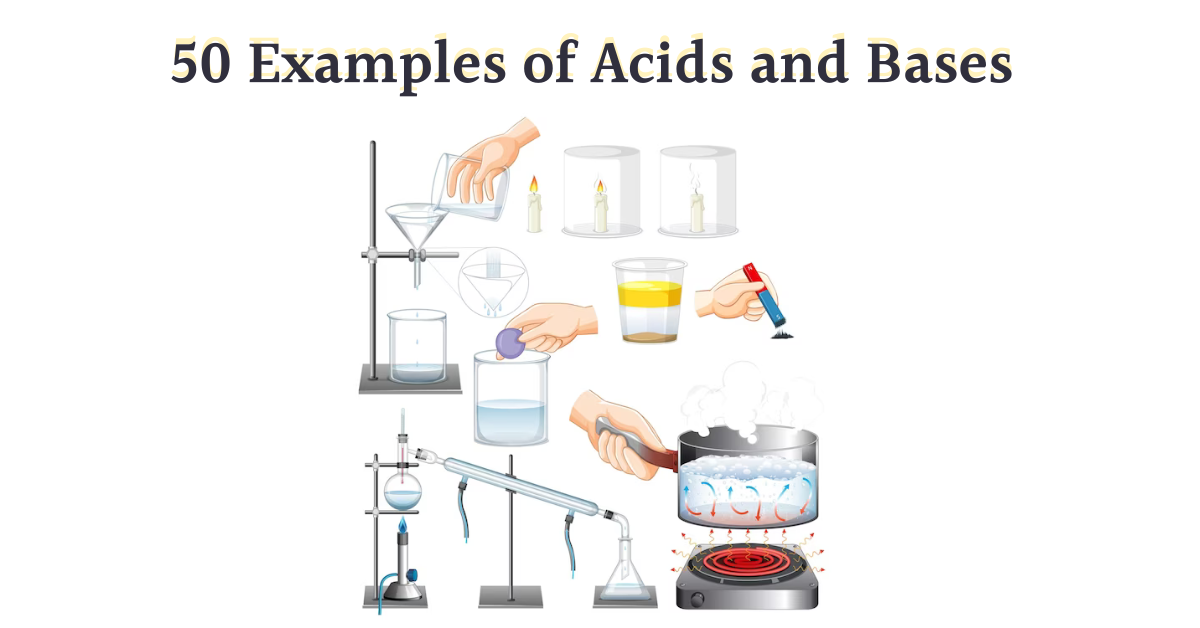Acids and bases are fundamental concepts in chemistry that play crucial roles in various chemical reactions and everyday life. Understanding these substances is essential for students and enthusiasts alike.
What are Acids and Bases?
Acids and bases are types of chemical compounds that exhibit distinct properties. Acids are known for their ability to donate protons (H+) in a chemical reaction, while bases accept protons. The strength of an acid or base is measured on the pH scale, ranging from 0 to 14. Substances with a pH below 7 are acidic, while those with a pH above 7 are basic. A pH of 7 is neutral.
Examples of Acids
- Hydrochloric acid (HCl)
- Sulfuric acid (H2SO4)
- Nitric acid (HNO3)
- Acetic acid (CH3COOH)
- Citric acid (C6H8O7)
- Phosphoric acid (H3PO4)
- Carbonic acid (H2CO3)
- Hydrofluoric acid (HF)
- Formic acid (HCOOH)
- Hydrobromic acid (HBr)

Examples of Strong Acids
- Perchloric acid (HClO4)
- Sulfuric acid (H2SO4)
- Nitric acid (HNO3)
- Hydroiodic acid (HI)
- Hydrochloric acid (HCl)
Examples of Weak Acids
- Acetic acid (CH3COOH)
- Citric acid (C6H8O7)
- Formic acid (HCOOH)
- Carbonic acid (H2CO3)
- Phosphoric acid (H3PO4)
Examples of Bases
- Sodium hydroxide (NaOH)
- Potassium hydroxide (KOH)
- Calcium hydroxide (Ca(OH)2)
- Ammonium hydroxide (NH4OH)
- Magnesium hydroxide (Mg(OH)2)
- Aluminum hydroxide (Al(OH)3)
- Barium hydroxide (Ba(OH)2)
- Lithium hydroxide (LiOH)
- Zinc hydroxide (Zn(OH)2)
- Strontium hydroxide (Sr(OH)2)
Examples of Strong Bases
- Sodium hydroxide (NaOH)
- Potassium hydroxide (KOH)
- Barium hydroxide (Ba(OH)2)
- Calcium hydroxide (Ca(OH)2)
- Strontium hydroxide (Sr(OH)2)
Examples of Weak Bases
- Ammonium hydroxide (NH4OH)
- Aluminum hydroxide (Al(OH)3)
- Magnesium hydroxide (Mg(OH)2)
- Zinc hydroxide (Zn(OH)2)
- Lithium hydroxide (LiOH)

Application of Acid and Base
- Battery acid (sulfuric acid) in car batteries
- Vinegar (acetic acid) for cooking
- Lemon juice (citric acid) in beverages
- Aspirin (acetylsalicylic acid) as a medication
- Antacids (bases) for indigestion relief
- Ammonia (NH3) in cleaning agents
- Lye (sodium hydroxide) in soap making
- Tums (calcium carbonate) for heartburn relief
- Baking soda (sodium bicarbonate) in baking
- Milk of magnesia (magnesium hydroxide) as an antacid
Conclusion
Acids and bases are important for cooking and industry. Understanding their properties helps in decision-making. Check out 50 examples to expand your chemistry knowledge. Acids and bases are compounds with varied and versatile applications that influence many aspects of our daily lives. They play an essential role in cooking and industrial processes, making it crucial to understand their properties and uses. By gaining knowledge about these substances, we can comprehend chemical reactions and make informed decisions in different fields. To expand your understanding of chemistry, consider these 50 examples as a solid foundation.

